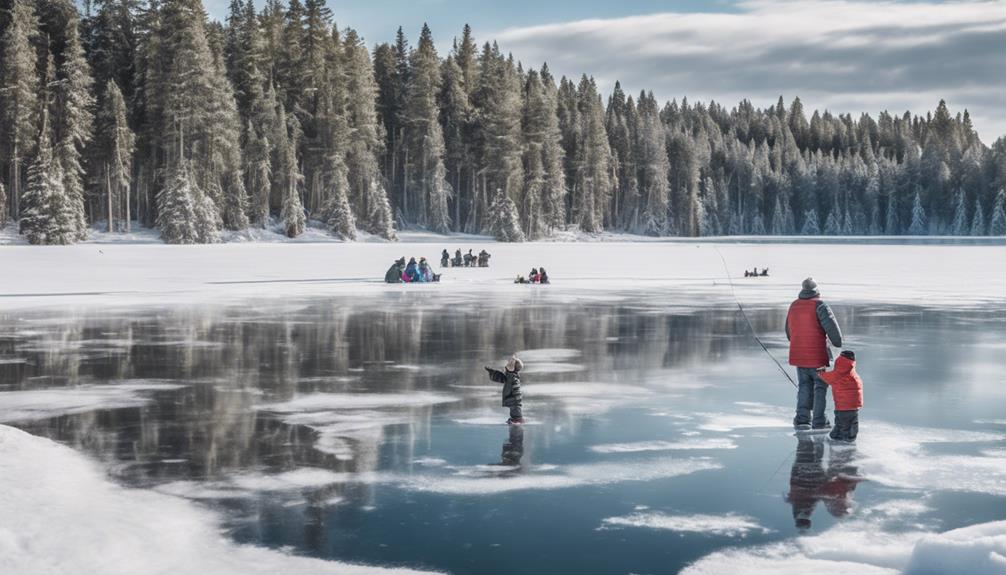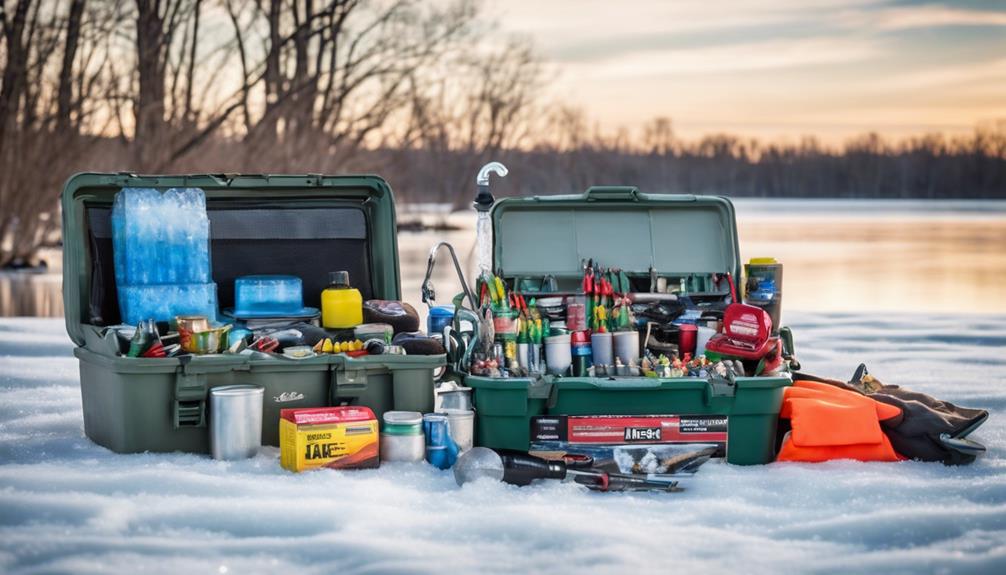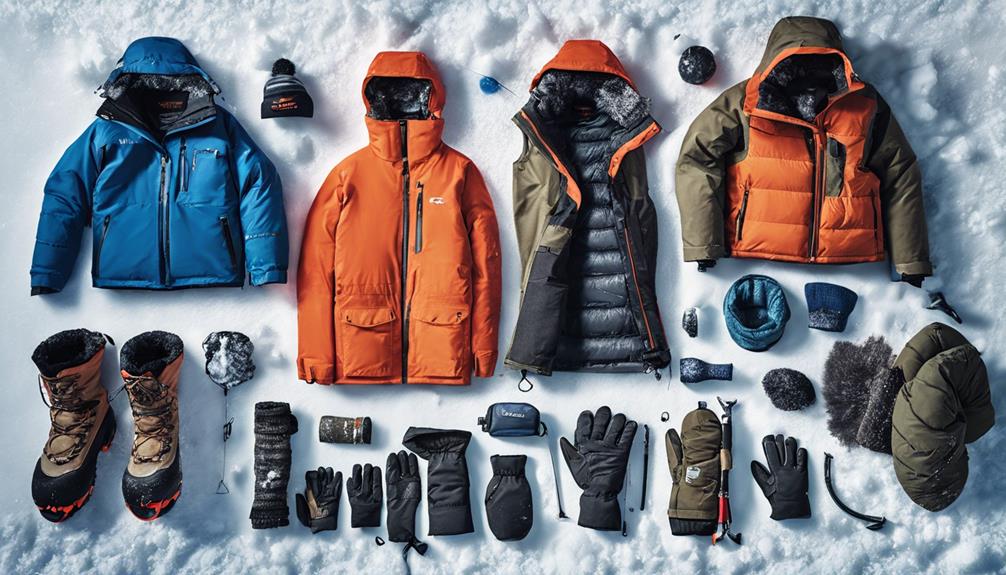When it comes to ice fishing, you've probably heard the saying, 'The early bird catches the worm.'
The same principle applies to using live bait effectively in frozen waters.
Curious to know why seasoned anglers swear by live bait over artificial lures in ice fishing?
Stay tuned to uncover the secrets behind the effectiveness of live bait and how it can significantly improve your catch rates on the ice.
Benefits of Using Live Bait
When ice fishing, using live bait can significantly increase your chances of catching fish. The advantages of using live bait are numerous. Live bait appears more natural in the water, enticing fish to bite. Its movement mimics that of real prey, attracting fish that mightn't be tempted by artificial lures. Additionally, live bait releases natural scents that can be irresistible to fish in the cold waters beneath the ice.
However, there are some disadvantages to using live bait as well. It can be more challenging to keep alive in freezing temperatures, requiring special containers or techniques to prevent it from perishing. Live bait also requires more maintenance and care compared to artificial lures.
When presenting live bait while ice fishing, it's crucial to position it strategically. Place the live bait close to the bottom of the water, where many fish species tend to swim during the winter months. Pay attention to any movements or vibrations on the line, as this could indicate a fish showing interest in your live bait. By positioning your live bait effectively and being attentive to any signs of fish activity, you can maximize your chances of a successful ice fishing outing.
Types of Live Bait for Ice Fishing
To enhance your ice fishing success, consider utilizing various types of live bait tailored to the fish species you're targeting. When selecting live bait for ice fishing, it's essential to take into account the bait preferences and seasonal availability to increase your chances of a successful catch. Here are some common types of live bait you can use:
- Waxworms: Waxworms are a popular choice for ice fishing due to their durability and ability to attract a wide range of fish species. They're especially effective for catching panfish like bluegill and perch.
- Minnows: Minnows are versatile live bait that can be used to target a variety of fish, including walleye, pike, and bass. They're readily available in most bait shops and can be used throughout the ice fishing season.
- Mealworms: Mealworms are another excellent option for ice fishing, particularly for species like trout and crappie. They're easy to store and can last a long time on the hook, making them a convenient choice for anglers.
- Maggots: Maggots are effective live bait for ice fishing, especially when targeting species like trout and whitefish. They're small, making them ideal for finicky fish and can be used in combination with other baits for added effectiveness.
How Live Bait Attracts Fish
Considering the diverse types of live bait available for ice fishing, understanding how these baits attract fish is crucial for maximizing your chances of a successful catch. Live bait possesses distinct advantages over artificial lures due to its natural movement and scent, which play key roles in enticing fish to bite. The lifelike motion of live bait, such as minnows or worms, mimics real prey, triggering predatory instincts in fish. This natural movement is often more effective in attracting fish compared to the mechanical actions of artificial lures. Additionally, live bait releases scents that fish find irresistible, further increasing its appeal.
The scent emitted by live bait acts as a potent attractant, drawing fish towards your hook even in cold, murky waters where visibility is limited. The natural odors released by live bait can signal to fish that an easy meal is nearby, enticing them to investigate further and potentially strike. This sensory advantage is particularly beneficial when targeting species with a keen sense of smell, such as trout or walleye. By leveraging both the natural movement and scent of live bait, anglers can capitalize on the innate feeding behaviors of fish, significantly improving their chances of a successful ice fishing outing.
Tips for Using Live Bait
Maximizing your success with live bait in ice fishing requires strategic presentation and proper handling techniques. To enhance your chances of landing a good catch, follow these essential tips:
- Bait Presentation: When using live bait for ice fishing, it's crucial to present it in a natural and enticing manner. Ensure that the bait is lively and active to attract fish effectively. Match the hook size to the bait you're using—smaller hooks for smaller bait and larger hooks for bigger bait.
- Depth Adjustment: Experiment with different depths until you find where the fish are actively feeding. Start by fishing closer to the bottom and gradually work your way up until you start getting bites. Remember, fish behavior can vary, so be willing to adjust your depth accordingly.
- Jigging Rhythm: Mastering the art of jigging is key to enticing fish to bite. Find a rhythm that mimics the movement of natural prey, such as small minnows or insects. Vary your jigging technique by occasionally pausing or changing the speed to keep the fish interested.
- Stay Alert: Ice fishing requires patience and attention. Stay alert for any signs of fish activity, such as slight twitches on your line or movement on the fishfinder. Be ready to react quickly to hook the fish when they bite.
Best Practices for Live Bait Storage
Properly storing live bait is crucial for maintaining its freshness and effectiveness in ice fishing. To ensure your bait stays lively and attractive to fish, two key factors to consider are temperature regulation and proper aeration.
Firstly, temperature regulation is essential for preserving live bait. Most live bait, such as minnows or worms, thrive in cool temperatures. It's important to keep your bait out of direct sunlight and away from heat sources to prevent overheating. Ideally, store your bait in a cooler with ice packs to maintain a consistent and cool environment. Avoid exposing the bait to extreme cold as well, as this can harm or even kill the bait.
Secondly, proper aeration is vital for keeping your live bait active and vigorous. Adequate oxygen levels are necessary to ensure the bait remains lively and appealing to fish. You can achieve this by using an aerated bait bucket or adding an airstone to the bait container. Regularly changing the water and removing any debris will also help maintain a healthy environment for the bait.
Live Bait Vs. Artificial Lures
When choosing between live bait and artificial lures for ice fishing, consider the advantages and drawbacks of each option.
- Live Bait Advantages:
- Live bait can be more appealing to fish due to its natural scent, movement, and appearance.
- It can attract a wider range of fish species compared to artificial lures.
- Live bait can be easier to use for beginners as it requires less technique to mimic natural prey.
- Artificial Lures:
- Artificial lures have the advantage of being reusable and convenient as they don't require frequent replacement like live bait.
- They also come in a variety of shapes, sizes, and colors, allowing you to match the lure to the specific fish species you're targeting.
- Artificial lures can be effective in imitating the movement of prey and can be used strategically to attract certain types of fish.
- Live Bait Effectiveness:
- Live bait is highly effective in ice fishing, especially in colder water when fish are less active.
- The natural movement of live bait can trigger more bites from fish that may be hesitant to strike artificial lures.
- Incorporating live bait into your fishing strategy can increase your chances of success on the ice.
- Fishing Strategy:
- When deciding between live bait and artificial lures, consider the fish species you're targeting, the water conditions, and your level of experience.
- Experimenting with both live bait and artificial lures can help you determine which option works best for you in different fishing scenarios.
Live Bait Techniques for Ice Fishing

Considering the effectiveness of live bait in ice fishing, mastering specific techniques can significantly enhance your chances of success on the frozen water. Bait presentation plays a crucial role in enticing fish under the ice. Understanding fish behavior in cold temperatures is key to adapting your bait presentation. Fish tend to be less active in winter, so presenting the bait in a slow and subtle manner is essential to attract their attention.
Temperature effects on live bait movement shouldn't be underestimated. As water temperatures drop, the metabolism of the bait decreases, resulting in slower movement. Adjusting your bait movement accordingly is vital. A slow and natural movement will appear more appealing to fish in cold waters.
Experimenting with different bait sizes and types can help determine what fish are more responsive to on a particular day. Smaller baits might be more effective when fish are less active, while larger baits can attract bigger predators seeking a substantial meal.
Lastly, staying observant and adapting your techniques based on the fish's response is crucial. If you notice fish aren't responding to a certain presentation, don't hesitate to change it up until you find what works best. By honing your live bait techniques for ice fishing, you increase your chances of a successful day on the ice.
Safety Considerations When Using Live Bait
To ensure safe handling of live bait while ice fishing, always be mindful of potential risks and take necessary precautions. When using live bait, it's crucial to prioritize safety to enjoy a successful and incident-free fishing experience. Here are some essential safety considerations to keep in mind:
- Proper Handling: Follow regulations regarding the use of live bait in your area. Always use clean containers to transport live bait and avoid mixing different species to prevent potential harm to the bait.
- Health Risks: Be aware of the health risks associated with handling live bait, such as bacteria and parasites. To minimize these risks, wash your hands thoroughly after handling bait and avoid touching your face or mouth.
- Precautions: Use gloves or bait towels when handling live bait to protect your skin from any potential irritants or pathogens. Additionally, store live bait in a cool and well-ventilated place to maintain its freshness and reduce health risks.
- Regulations: Familiarize yourself with local regulations regarding the use of live bait, including any restrictions on certain species or bait sizes. Adhering to these regulations not only ensures your safety but also promotes sustainable fishing practices.
Frequently Asked Questions
Can Live Bait Be Used for Ice Fishing in All Types of Bodies of Water, or Are There Certain Conditions Where It Is Not Recommended?
When ice fishing, you can use live bait in various bodies of water, but some conditions may not be ideal. Factors like water depth, temperature, and the type of fish you're targeting can affect live bait effectiveness. Properly storing and handling live bait is crucial for success.
Understanding ice fishing techniques and choosing the right location based on these factors will increase your chances of a successful ice fishing trip.
Are There Any Regulations or Restrictions on Using Live Bait for Ice Fishing in Certain Regions or Lakes?
In some regions or lakes, there are regulations and restrictions on using live bait for ice fishing. Before you head out, check local rules to ensure you're following the guidelines.
These regulations aim to protect the aquatic ecosystems and ensure sustainable fishing practices. By being aware of any restrictions on live bait, you can still enjoy successful ice fishing by adapting your techniques and using alternative bait options.
How Often Should Live Bait Be Replaced or Refreshed While Ice Fishing to Maintain Its Effectiveness?
When ice fishing, replace live bait every 15-20 minutes to keep it fresh. Proper bait storage in insulated containers can extend its longevity. This frequent change helps attract fish consistently.
Are There Any Specific Live Bait Species That Are Known to Be More Effective for Catching Certain Types of Fish During Ice Fishing?
When ice fishing, certain live bait preferences can significantly boost your chances of success. Different fish species have their own preferences, so understanding which live bait is more effective for each type can enhance your ice fishing tactics.
For example, using minnows for walleye or waxworms for panfish can attract the right kind of fish. Experimenting with various live bait options based on the species you're targeting can improve your ice fishing strategies.
What Are Some Common Mistakes or Pitfalls to Avoid When Using Live Bait for Ice Fishing to Ensure a Successful Fishing Trip?
When ice fishing with live bait, proper bait storage and handling are crucial for success. Avoid common mistakes like using thawed or dead bait, which won't attract fish.
Ensure your bait presentation is appealing by using the right technique. Keep your live bait alive and lively by maintaining proper temperature and oxygen levels.
Conclusion
So, now you know why live bait is so effective for ice fishing. Its natural movement and scent attract fish in cold waters, increasing your chances of a successful catch.
Remember to choose the right type of live bait, store it properly, and use it with proper techniques for the best results.
Stay safe while using live bait and enjoy a successful ice fishing experience!



